William Weaver, Buffalo Forge and Paid Slave Labor
New Earliest Known Use for Richmond Print - July 25, 1862
by Patricia A. Kaufmann
This article appeared in The Confederate Philatelist, Volume 50, Number 1, Whole Number 344, January-March 2005. Additional photos have been added to the on-line version for those not as well versed in Confederate postal history or just for the pleasure of those who are. Since this was published, the date has been getting consistently earlier. In 2008 the CSA Authentication Service gave certificates to July 13 and July 15, 1862 uses on cover and folded letter. While this makes this article "obsolete" in part, the Weaver history is fascinating and the articles spurred readers to look more carefully at their stocks and collections.
New Earliest Known Use
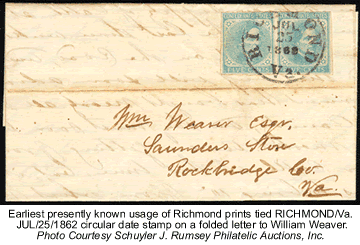 For years, the date for the earliest known use (EKU) of a Richmond (or Local) Print (Scott #7) has stood at August 15, 1862 as promoted by the father of Confederate philately, August Dietz. There is really no other reason for this particular date to have stood the test of time except that the Dietz name was attached to it. For years, collectors and dealers have simply identified 5¢ typographed issues as De La Rue (Scott #6) printings if they preceded the magic August 15, 1862 date. This date has stood for nearly 60 years since Stanley B. Ashbrook first reported it in 1946 in the Emerald Book of The Stamp Specialist. 1
For years, the date for the earliest known use (EKU) of a Richmond (or Local) Print (Scott #7) has stood at August 15, 1862 as promoted by the father of Confederate philately, August Dietz. There is really no other reason for this particular date to have stood the test of time except that the Dietz name was attached to it. For years, collectors and dealers have simply identified 5¢ typographed issues as De La Rue (Scott #6) printings if they preceded the magic August 15, 1862 date. This date has stood for nearly 60 years since Stanley B. Ashbrook first reported it in 1946 in the Emerald Book of The Stamp Specialist. 1
A number of years ago, Scott Trepel of Robert A. Siegel Auction Galleries came across an earlier pair from Richmond dated August 13, 1862 and included it on the "Civil War Timeline" information on the Siegel Web site.2 For a number of reasons, this did not make it to the record books.3 It was from the John Hill collection and it is still out there somewhere, now the second earliest usage known.
In September 2004, a pair of Richmond prints with a clear RICHMOND/Va./JUL/25/1862 circular date stamp affixed to a folded letter headed "Richmond July 24th 62" was given a certificate as genuine by the Confederate Stamp Alliance Authentication Committee. This article tells the story behind that new presently earliest known usage.
The Typographed Issues
The story of the London prints (printed by Thomas De La Rue & Co., Ltd. in London) and Richmond prints (printed "locally" by Archer and Daly in Richmond) is a familiar one to most Confederate philatelists. Well known engravers Thomas De La Rue & Co. Ltd. were commissioned to engrave the designs and make electrotype plates for both 1¢ and 5¢ denominations.4 There appear to be a minimum of three 5¢ printing plates.5 One was used in London and melted down by De La Rue when no longer needed, as was their custom. The second was the printing plate and finished stamps that were placed on board the Confederate blockade runner Bermuda. The vessel was captured by the Federal warship Mercedita and taken to Philadelphia where the Federal Prize Court ordered her cargo destroyed.6 In 1954, it was discovered that the 5¢ plate had actually avoided destruction and is today in the possession of the Franklin Institute in Philadelphia where I saw it on display in the late 1960's. The vessel name is spelled incorrectly in the New Dietz as "Mercidita", probably because of the Lost Plate document with the only documented copy of a sample stamp, which I had the pleasure of handling at auction in the 1980's. The vessel was misspelled "Mercidita" in that document.
Another lot of stamps was ordered from De La Rue, as well as a duplicate electrotype plate in order to print stamps locally in Richmond. The second shipment was placed aboard a ship that successfully ran the blockade and arrived safely in Wilmington, NC in April 1862. That was the third plate. The stamps were immediately sent to Richmond to be distributed and the firm of Archer and Daly was contracted to print the additional stamps that we now call "local prints" or "Richmond prints" from the plates supplied by De La Rue. The De La Rue Day Book entry of a 5¢ plate shipped on the Bermuda March 24, 1862 is proof that an additional 5¢ plate or plates were planned before the previous plate shipped to the CSA was captured on April 27, 1862.7
The initial Archer and Daly contract to print from the De La Rue plates was June 30, 1962.8 Logic dictates that there was certainly some delay in the actual commencement of printing, but any date some time from then forward to this presently accepted new EKU has potential as an even earlier usage.
 The London prints were clearly printed in a clear light blue on a thin white wove hard-surfaced paper with even colorless, almost transparent, gum. There are few recognizable varieties. By contrast, the Richmond ("local") printings were inferior in virtually every respect with wide color variations and innumerable flaws. The paper was in two distinct grades: the thin, glazed paper imported from England and a thick coarse paper of inferior quality. Later gums varied considerably in character, color and application.
The London prints were clearly printed in a clear light blue on a thin white wove hard-surfaced paper with even colorless, almost transparent, gum. There are few recognizable varieties. By contrast, the Richmond ("local") printings were inferior in virtually every respect with wide color variations and innumerable flaws. The paper was in two distinct grades: the thin, glazed paper imported from England and a thick coarse paper of inferior quality. Later gums varied considerably in character, color and application.
One would think, given the differences in printing quality, that it would be easy to tell the difference between the two printings. As with many things, sometimes it is and sometimes it isn't. There is a "gray area" that gives even students with decades of experience pause. It is simply not always so clear cut.
If you are fascinated by the differences and similarities of the typographed issues, I highly recommend Leonard H. Hartmann's article "The De La Rue 5¢ Typographed Plate for the Confederate States of America" in the May 2002 issue of The Chronicle, which is a benchmark on this subject and goes into far more detail than warranted for this article.
George N. Malpass - Prolific Collector
George N. Malpass was one of the most passionate collectors of both Union and Confederate material for six decades. His philatelic interests began in 1915 and he soon became infatuated with the postal history of the Civil War, particularly patriotic envelopes. His collection of stamps, covers, autographs, and manuscripts was one of the most comprehensive ever assembled, at one time numbering over 12,000 items. He joined the Confederate Stamp Alliance in 1937 and served on the editorial boards of the 1945 and 1959 Dietz Confederate Catalog and Handbook. His mentor was the late great August Dietz. Malpass wrote hundreds of articles, particularly in the Weekly Philatelic Gossip in the1940's and 50's. He was president of the Confederate Stamp Alliance from 1955-57 and proud of the fact that the Confederate Bulletin began under his administration. It was the precursor to today's Confederate Philatelist. In 1953, he won the grand award at the SPA convention in Tampa, FL and was widely known and respected during that era as an exhibitor and premier researcher.
George Malpass died in 1976, but his legacy lives on. Over the last few decades, his collection was piecemealed out to various dealers. This most recently discovered lot of material was consigned to the San Francisco auction house of Schuyler J. Rumsey Philatelic Auctions, Inc. and sold in their December 2004 sale. Most of us thought this material had long ago been disseminated, so it was a treat to see it all in one catalog with proper provenance.
I had the distinct pleasure of viewing the collection before it was consigned to auction. The Malpass heir came to me for advice, having no idea what his material was worth. The first shock was mine when I casually asked the name of his "late uncle who had boxes of Confederate covers". I reacted with an involuntary gasp. I was simply flabbergasted that he could have literally thousands of covers from a prominent collector who had died decades before.
I am ordinarily an early morning person, but I was so excited by the Malpass material that I stayed up until 2 AM poring through it - very unusual for me. I got up again only 3 hours later at 5 AM, unable to sleep. I spent close to 37 hours straight examining it and, in particular, simply sorting it. One thing that amazed me was that it literally looked as if someone had thrown it up in the air and then swept it together in a heap like a giant game of "52-Pickup".
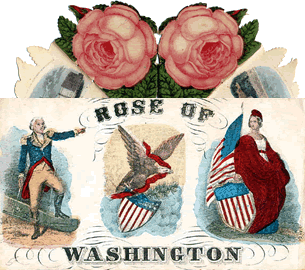 Malpass was meticulous and kept inventories and voluminous notes, yet I would find a box of common unused Union patriotics with a spectacular Confederate item mixed in. Sets were broken up and scattered. Union material comprised 70% of the material, although I didn't know that right away in my intuitive hunt for Confederates. I spent hour upon hour just sorting through myriad boxes of flamboyant and rare patriotics, incredible soldiers' letters full of battle details, historical cartes-de-visite, colorful Civil War songsheets, an incredible selection of gorgeous Roses of Washington and covers with designs that I had never seen before in nearly 40 years of experience with Civil War material…and on and on. I was in postal history heaven!
Malpass was meticulous and kept inventories and voluminous notes, yet I would find a box of common unused Union patriotics with a spectacular Confederate item mixed in. Sets were broken up and scattered. Union material comprised 70% of the material, although I didn't know that right away in my intuitive hunt for Confederates. I spent hour upon hour just sorting through myriad boxes of flamboyant and rare patriotics, incredible soldiers' letters full of battle details, historical cartes-de-visite, colorful Civil War songsheets, an incredible selection of gorgeous Roses of Washington and covers with designs that I had never seen before in nearly 40 years of experience with Civil War material…and on and on. I was in postal history heaven!
The heir had left the material with me to examine for 3 days. We touched base several times by cell phone as my work progressed and he and his wife enjoyed the Delaware beaches and surrounding areas. When I mentioned how strange it was that the covers were so unorganized, he astounded me by revealing that when the last of the Malpass children died, this remaining batch of stamps and covers was literally rescued from where it had been unceremoniously dumped on a curbside trash heap while he was helping clean out the house. Wow! What a tragic loss that would have been to postal history. Fortunately, he knew that there was some value to the material. He just had no idea how much. Was he ever in for a pleasant surprise.
After examining the material, it was the heir's turn to be astonished when I gave him a 6-figure appraisal. The Rumsey pre-sale auction estimates totaled from the individual lot descriptions, not done by me, also came within this same range. When the last lot was gaveled down, the hammer price came in 50% over estimate after very spirited bidding from book, phone, floor and agents. Schuyler told me that his dream was that the heir made a mistake and found some more material. Mine too. It was an exciting lot that hadn't been offered to collectors in decades.
One of the many items in this remaining portion of the Malpass collection was a rather ordinary looking folded letter bearing a pair of 5¢ typographs with a July 25, 1862 date. With it was a typical typewritten Malpass note indicating that the then experts were divided as to whether this was a Richmond or London print. In my personal opinion, it was a Richmond print. I advised the owner to get a CSA certificate before it was offered for sale. After the patient made the rounds more than once, the Confederate Stamp Alliance Authentication Committee gave it a certificate as a genuine pair of Richmond prints.
William Weaver - Consummate Businessman and Slave Holder
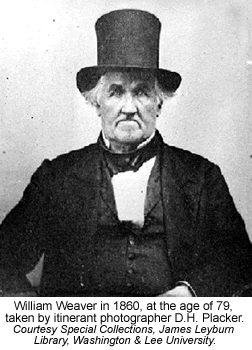 The pair of Richmond prints with a clear RICHMOND / Va // JUL / 25 / 1862 circular date stamp is affixed to a folded letter headed "Richmond July 24th 62" from R. H. Crockett to "Wm. Weaver, Esqr, Saunders Store, Rockbridge Co., Va." Coincidentally, this is the same currently accepted earliest known date for the J.T. Paterson & Co. print of the 10¢ blue lithograph, Scott #2. 9, 10
The pair of Richmond prints with a clear RICHMOND / Va // JUL / 25 / 1862 circular date stamp is affixed to a folded letter headed "Richmond July 24th 62" from R. H. Crockett to "Wm. Weaver, Esqr, Saunders Store, Rockbridge Co., Va." Coincidentally, this is the same currently accepted earliest known date for the J.T. Paterson & Co. print of the 10¢ blue lithograph, Scott #2. 9, 10
Although today we usually think of the title "esquire" as referring to an attorney, Merriam-Webster defines the term as "used as a title of courtesy usually placed in its abbreviated form (Esq.) after the surname". The archaic definition was "a landed proprietor" and William Weaver certainly was certainly that in spades.
The contents of the business letter read as follows:
Richmond July 24th 62
Mr. Wm. Weaver
D Sir, --Yours of the 21st is at hand. We have a heavy supply of cattle at this time, and have had for the last three weeks, but there are now no cattle on the road, and I am satisfied that beef will soon advance. The Government has bought nearly all the cattle in the County, and they must soon be scarce in this market like one getting from 8 to 10 @ gross for cattle at this time, but it takes good ones to bring 10 @ from what you say about yours, I think they wont bring it. And if the market improves, which I think it will, they will bring a higher price. I don't think there is any danger of the cattle being taken by the Gov. as they have a good supply, and they have taken none yet. They will be more likely to take them later in the season, as they will then need them more. I am now doing business with John G. Moffett, of Augusta, and we think we can make as much, if not a little more, out of your cattle than any other one in this market. Let us know when you start them. I wont start them for some ten days yet.
Yours Respectfully,
R. H. Crockett
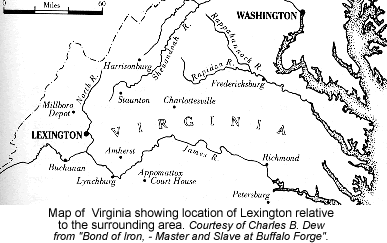 I had no success in finding an R.H. Crockett from Virginia, only Arkansas, but it was quite a different story with William Weaver of Rockbridge County, Virginia who was a very well known and respected businessman of the times. Initially, I was not sure that the William Weaver of the correspondence was "the" Weaver, as it has the ring of a somewhat common name. The "Saunders Store" reference in the address, however, proved conclusively that this was the correct identification. 11
I had no success in finding an R.H. Crockett from Virginia, only Arkansas, but it was quite a different story with William Weaver of Rockbridge County, Virginia who was a very well known and respected businessman of the times. Initially, I was not sure that the William Weaver of the correspondence was "the" Weaver, as it has the ring of a somewhat common name. The "Saunders Store" reference in the address, however, proved conclusively that this was the correct identification. 11
One of the first iron blast furnaces was Marlboro Works, in Frederick County, Virginia, which was begun by Isaac Zane. 12 Rockbridge County had its first iron furnace producing bar iron by 1800. The iron industry really began to boom when iron masters like William Weaver entered the Valley. Weaver moved to Virginia from Philadelphia in 1815 to become more involved in his iron business. He owned over 7,800 acres of land just at Buffalo Forge, formerly known as Union Forge. He also owned Bath Iron Works, formerly known as Lydia Furnace, later Bath Furnace and Bath Forge, both of which were later known as Bath Iron Works in Rockbridge County.13 Weaver's iron blast furnaces still exist today just a few miles from Lexington where they may be visited.14
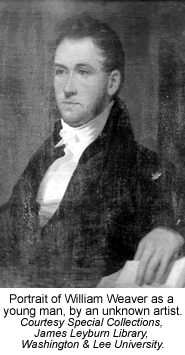 One of the several fascinating books that I found about Weaver was Bond of Iron - Master and Slave at Buffalo Forge by Charles B. Dew.15 Buffalo Forge was an extensive iron making and farming enterprise located approximately nine miles southeast of Lexington in the Valley of Virginia. It was bought by Weaver in 1812. By the Civil War, Weaver had amassed an extraordinary estate, including 70 slaves of his own plus 100 slaves hired annually to run his blast furnaces and farm his 20,000 acres.
One of the several fascinating books that I found about Weaver was Bond of Iron - Master and Slave at Buffalo Forge by Charles B. Dew.15 Buffalo Forge was an extensive iron making and farming enterprise located approximately nine miles southeast of Lexington in the Valley of Virginia. It was bought by Weaver in 1812. By the Civil War, Weaver had amassed an extraordinary estate, including 70 slaves of his own plus 100 slaves hired annually to run his blast furnaces and farm his 20,000 acres.
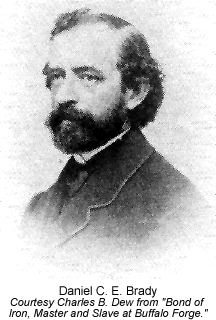 Daniel C. E. Brady was another Pennsylvanian, Weaver's nephew-in-law from Philadelphia whom he convinced to move to the Valley during the 1850's to help him manage the Buffalo Forge operations. By then, Weaver was getting on in years and Daniel Brady was an experienced merchant and commercial banker with a solid family life. He was also less than half Weaver's age.16 Brady was clearly the heir apparent.
Daniel C. E. Brady was another Pennsylvanian, Weaver's nephew-in-law from Philadelphia whom he convinced to move to the Valley during the 1850's to help him manage the Buffalo Forge operations. By then, Weaver was getting on in years and Daniel Brady was an experienced merchant and commercial banker with a solid family life. He was also less than half Weaver's age.16 Brady was clearly the heir apparent.
Buffalo Forge was a multi-purpose complex comprised of industrial plant, business office, farming community, mercantile store to sell goods to slaves and surrounding neighbors, transportation to move the iron to market - usually in Richmond - and neighborhood for the families of both master and slave. It was also fully integrated. Whites, free blacks and slaves worked side by side during much of its operation. Black family houses were scattered around the site rather than in one separate section. Buffalo Forge was very much a self sustaining operation. They mined their own ore, operated furnaces and forges, built their own structures, farmed their food, cut timber, and supplied their own fuel and power.
Weaver was the great-grandson of the founder of the German Baptist Church, pietists better known as the "Dunkers". His father was Adam Weaver, and his mother was Hannah Mack Weaver. Hannah's grandfather, the Reverend Alexander Mack, had founded the sect in Germany and in 1729 led a major migration of Dunker families to the Germantown area of Pennsylvania. Their distinguishing baptismal procedure of immersion by 3 separate forward actions in a flowing stream, gave the Dunkers their more popular designation. They referred to each other as "brother" and "sister", which reflected their belief in the universal Christian brotherhood. Weaver was born into this religious tradition on March 8, 1781 on the family farm near Flourtown, Pennsylvania. According to Dew, he grew into a strikingly handsome man with "dark brown hair, a strong jaw, and the straight line of his prominent nose all complemented his eyes, light blue in color, which remained clear and arresting throughout his long life." 17
Weaver lived with his parents in Flourtown until his late twenties, but was not content to remain a farmer. 18 He also became a miller, merchant, and textile manufacturer. He seemed to have a knack for all of these endeavors and, as a result, began accumulating enough surplus capital to take advantage of new business opportunities as they arose. When the War of 1812 broke out, he tried his hand at such speculative ventures as running the British naval blockade and iron manufacturing in the Valley of Virginia. Weaver found that the free White laborers were very poor workmen, while slave laborers, on the other hand, were excellent.
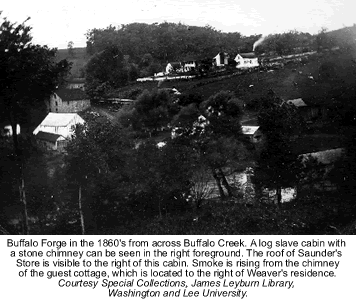 Thus it was that Weaver moved away from both his northern roots and religious customs to become one of the largest slave holders in the Valley. He bought his first slaves in October 1815. He seemed to have no hesitation in using slaves. He never appeared on the books as an official member of the Dunkers, so he must have realized the religious and business conflicts early in life..
Thus it was that Weaver moved away from both his northern roots and religious customs to become one of the largest slave holders in the Valley. He bought his first slaves in October 1815. He seemed to have no hesitation in using slaves. He never appeared on the books as an official member of the Dunkers, so he must have realized the religious and business conflicts early in life..
Since the Dunkers (or Brethren) had migrated from Pennsylvania into a few southern States with significant slave populations, the issue of slavery or even paying slaves would inevitably confront them at their Annual Conference. The earliest record of an official mention was in their Annual Conference minutes for 1797, held at Blackwater, Virginia: "It was considered good, and also concluded unanimously, that no brother or sister should have negroes as slaves; and in case a brother or sister had such he or she was to set them free. Proclaimed at the 1855 conference, "(concerning) Brethren who hire a slave or slaves, and paying wages to their owners, we do not approve of it. The same is attended with evil which is combined with slavery. It is taking hold of the same evil which we cannot encourage, and should be banished and put from among us, and cannot be tolerated in the church." 19
Weaver was a consummate businessman who addressed the problems of management and labor with skillful determination. He apparently did not have enough funds to buy sufficient slave workers, so he hired them instead. Although the white workers appeared to be more efficient in the production process, the slaves were more reliable and created fewer problems outside of work. He was never able to completely eliminate the use of white workers, often hiring slave labor from the available market; but he strived to maximize the use of his own chattel slaves to the greatest extent circumstances allowed. Skilled black workers earned on average three times the wages of white Confederate soldiers and more than most Confederate army officers ($350- $600 a year). 20
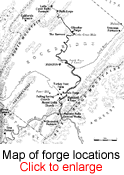 The iron making industry provided many jobs for the Valley of Virginia. But the industry in Virginia was driven by slavery. James C. Dickinson of Louisa County, Virginia wrote a letter to William Weaver in 1833 which tells us a great deal about the industrial phase of the South's "peculiar institution".21 It demonstrates the dependence of many southern manufacturers on skilled slave artisans, and suggests the reliance many industrialists had in hired slave labor. It also reveals the lengths to which some employers would go in their efforts to secure key slave workers in a highly competitive hiring market. The fact that Weaver found it necessary to offer money to a slave to persuade the man to work for him is very telling. Because of their skills, the Buffalo Forge slaves enjoyed an extraordinary amount of freedom. They could earn extra wages by working overtime or exceeding production goals. They used the excess income to purchase luxuries at the company store.
The iron making industry provided many jobs for the Valley of Virginia. But the industry in Virginia was driven by slavery. James C. Dickinson of Louisa County, Virginia wrote a letter to William Weaver in 1833 which tells us a great deal about the industrial phase of the South's "peculiar institution".21 It demonstrates the dependence of many southern manufacturers on skilled slave artisans, and suggests the reliance many industrialists had in hired slave labor. It also reveals the lengths to which some employers would go in their efforts to secure key slave workers in a highly competitive hiring market. The fact that Weaver found it necessary to offer money to a slave to persuade the man to work for him is very telling. Because of their skills, the Buffalo Forge slaves enjoyed an extraordinary amount of freedom. They could earn extra wages by working overtime or exceeding production goals. They used the excess income to purchase luxuries at the company store. 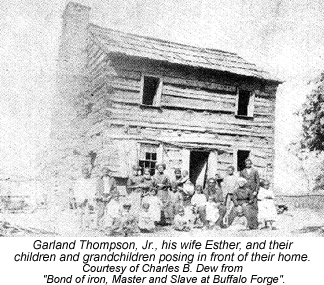 They kept their families together and passed their skills down to their children. Despite their enslavement, they negotiated a life more similar to a feudal serf rather than a slave. Weaver was thought of very highly by blacks, who regarded him as a fair master, although lashing were meted out as punishment if warranted and there were the inevitable discipline problems.22 The slaves did not have the same high opinion of his wife, Eliza, who was very strict and feared by the slaves. 23
They kept their families together and passed their skills down to their children. Despite their enslavement, they negotiated a life more similar to a feudal serf rather than a slave. Weaver was thought of very highly by blacks, who regarded him as a fair master, although lashing were meted out as punishment if warranted and there were the inevitable discipline problems.22 The slaves did not have the same high opinion of his wife, Eliza, who was very strict and feared by the slaves. 23
Slaves possessing industrial skills had considerable leverage when it came to a test of wills with white masters and employers. There is no question that force and coercion were the glue that held slavery together in the South, and industrial slavery was no exception. There were certainly no willing slaves. But if a slave did not challenge the institution openly, did not try to run away or carry resistance to levels that the master considered intolerable, the industrial system offered the slave a chance to earn considerable rewards. Blacks engaged in manufacturing enterprises frequently showed an impressive ability to use this to their advantage, as the Weaver papers demonstrate time and again. They are fascinating reading.
Weaver the Politician
It is clear that Weaver tried to hide his slave holdings from his Pennsylvania relatives. This is somewhat amusing considering that he ran several times for political office in Pennsylvania showing, in the vernacular, that there is nothing new under the sun. Political candidates all have their little sins of omission, which modern day journalists can more easily ferret out than in the past what with technological advances.
Only once did Weaver run for political office in Virginia. On April 8, 1845, he announced his Whig party candidacy as a latecomer to represent Rockbridge County in the Virginia General Assembly.24 Politics involving the James River and Kanawha Canal appear to have been the principal motive for declaring his candidacy. He was accused by an anonymous correspondent in an article in the Lexington Gazette of wanting the state to embark on "a grand and untried scheme of buying an immense number of negroes, and putting them under an overseer to carry on the work" of building the canal. The correspondent also accused him of being enamored by the sound of his own words. Weaver lost the election. He announced that he was running again the following year, but withdrew from the race a week later when he learned that the next session of legislature would be a very protracted one.
Weaver was clearly influential and politically well connected. Virginia Governor John Letcher invited Weaver to the inauguration of the new Confederate president, Jefferson Davis, and offered him a room in the Governor's Mansion if he would make the journey. The Weaver correspondence is similarly loaded with other names very familiar to Virginia postal historians e.g. Minor, Davidson, Lee and others.
Weaver and Brady - the War and its Aftermath
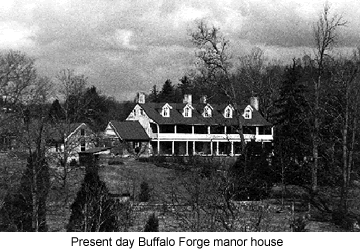 Former Pennsylvanians Weaver and Brady were initially opposed to Virginia seceding from the Union, but they wasted little time taking a public stand in favor of Virginia and the South.25 They donated money to help outfit a volunteer regiment and swore an oath of allegiance to the Commonwealth of Virginia. When the results of the state secession were announced, Buffalo Forge held a flag-raising to mark the occasion. 26
Former Pennsylvanians Weaver and Brady were initially opposed to Virginia seceding from the Union, but they wasted little time taking a public stand in favor of Virginia and the South.25 They donated money to help outfit a volunteer regiment and swore an oath of allegiance to the Commonwealth of Virginia. When the results of the state secession were announced, Buffalo Forge held a flag-raising to mark the occasion. 26
Weaver did not see the end of the War, dying on March 25, 1863. In the space of a single decade, the fortunes of the Buffalo Forge community had changed dramatically. The 1860 census showed Weaver as the owner of a vast iron plantation with 66 slaves. A decade later, the 1870 census revealed Brady as a farmer and indicated that the only industrial activity at Buffalo Forge took place in the flour and grist mills.27 It was unquestionably the end of an era.
Once the Civil War had ended and slavery had been abolished, it was almost impossible to find anyone skilled enough to work the furnace. Slavery ended at Buffalo Forge on May 26, 1865.28 Initially, the conversion to free labor and resumption of iron production after the War brought a measure of prosperity to Buffalo Forge. Post-War Buffalo Forge master Daniel Brady was paying the laborers pre-war rates while reaping higher prices, but as transportation systems recovered from wartime destruction and less expensive production from Northern mills flowed into the area, Brady found his iron priced out of the market.
Buffalo Forge operations came to a close soon after the collapse of the Confederacy. This would be the trend throughout the South where slavery played a crucial role in labor forces. The once flourishing and vital iron making industry was pretty much over for the South. While some sources attributed the decline of the furnaces to the War, others also cite the fact that Weaver had chosen not to modernize and had retained the traditional tilt-hammer technology to keep his slave forge men doing things the way they always had.29 This proved a serious downfall.
Scrupulous Record Keepers
Weaver and his successors were meticulous record keepers. A unique treasury of documents has survived - of births, marriages, illnesses and deaths - as well as working ledgers that provide an insight into the day-to-day life of the slave community of that period. It is one of the most well recorded industrial enterprises in the South.
The Special Collections Department of the Manuscripts Division of the University of Virginia Library in Charlottesville has a large collection of business papers from William Weaver concerning his mines, furnaces, and forges in Rockbridge, Rockingham, and Botetourt counties. The Virginia Historical Society also has 220 items from the papers of William Weaver. Another repository of William Weaver Papers is the Duke University Library. The most recent cache of Weaver and Brady material is in the Special Collections at Washington and Lee University in Lexington.
The State of Wisconsin, of all places, has the 1860-65 Journals of Daniel C. E. Brady as well as other pertinent papers. It seems that they were acquired by the McCormick Historical Association in Chicago and eventually transferred to Wisconsin in 1951.30 Cyrus Hall McCormick, inventor of the reaper, got his start in business as a Valley iron master. McCormick's "Virginia Reaper" hastened the westward expansion of the United States and won the highest award of the day, the Gold Medal at London's Crystal Palace Exhibition, making Cyrus McCormick a world celebrity. In 1853, Weaver had a McCormick reaper shipped in from Chicago to give it a try, but his wheat fields were too hilly for the machine to operate effectively. 31
The Many Post Offices of Buffalo Forge
I corresponded with Charles B. Dew who wrote Bond of Iron - Master and Slave at Buffalo Forge and he helped provide me with information on the current status of the Brady descendants.32 Today, Mary Brady (Mrs. Douglas E. Brady, Jr.) still lives in the beautiful manor house at Buffalo Forge. We had a delightful conversation. 33 Her late husband left a treasure trove of Buffalo Forge records in a Special Collection to Washington and Lee University in nearby Lexington only a few years ago. I initially made phone calls to six different "Mary Bradys" in the general vicinity before I found "the" Mary Brady. Before I made that last phone call, I just knew I finally had the right one when I saw that she lived on "Forge Road" in Glasgow. I was mainly looking to acquire permission to use some of the photos provided to Prof. Dew in his book that had been attributed to the Douglas E. Brady, Jr. Instead, a chance comment sent me off in yet another direction.
"You know," Mrs. Brady said after being told I was a postal historian, "there was a post office at Buffalo Forge, but I doubt you'd be able to find out much about it." She, of course, was quite wrong about that. That's what postal historians do best!
I knew where to find the information, but my own copies of the Virginia Postal History Society (VPHS) Catalog are missing some sections and are, dare I say, poorly organized. The VPHS Catalog is unfortunately not in one volume. It is sent to VPHS members a few pages at a time with the society journal, Way Markings. So I called my friend Peter Powell in Richmond. Pete kindly looked up the wandering course of the Buffalo Forge post office, which made sense only after researching the Buffalo Forge complex.
Peter had double checked his records, but it seemed sensible to check with Bob Lisbeth as well, who can look things up first hand at his job in the Library of Congress and literally "wrote the book" on Virginia markings for the Virginia Postal History Society. There were just some dates and names that seemed to need explanation. He helped clarify the dates and will literally have to change some things in upcoming catalog editions due to this research. The circuitous course of the Buffalo Forge post office appears as follows:
The Conundrum - two Buffalo Forge post offices?
Bob Lisbeth appears to have come up with some conflicting information on the Buffalo Forge post offices and is confident that there were two different Buffalo Forge post offices in Rockbridge County, Virginia. From two different postal sources (one printed and one handwritten, both official postal records), he confirmed that Sander's Store was established on August 23, 1854. He believes that the first post office of Buffalo Forge was established in 1827 at location #1, renamed Thompson's Landing in 1853, and discontinued as Thompson's Landing in 1859. He believes Buffalo Forge #2 started in 1854 as Sander's Store in location #2, changed to Miller's Lumber House in August 1865, and became Buffalo Forge #2 in March 1866. He believes that both post offices operated simultaneously in different locations for five years between 1854 and 1859. He theorizes that perhaps the postmaster in location #2 liked the Buffalo Forge name and so in 1866 used it since it had not been used since 1853. 40
The strength of two different types of post office records is pretty strong evidence in favor of Bob's theory. What leaves me pondering is that both locations had ties as one location via William Weaver and Daniel Brady. The Lisbeth designated Buffalo Forge #1 listed William Weaver as the postmaster while Buffalo Forge #2 listed Daniel Brady as the postmaster. The history of these two men is very well documented and they were clearly from the same large estate. The one way I could see the two post office theory being correct is that perhaps there were two separate post offices on the same enormous property in Rockbridge County. After all, Weaver owned 20,000 acres of land and Buffalo Forge comprised 7,800 acres of that. Perhaps location #1 was inconveniently located for the workers and thus a second post office was opened to accommodate another section of the large property more easily. Another thought is that there could have been one post office for blacks and another for whites. While neither Bob nor I have ever heard of such a thing, this thought occurred to both of us individually. I discounted that idea initially, because the black and white quarters were intermixed, but they certainly weren't "equal" and thus this is still a possibility. In my opinion, the only plausible explanation for there being two Buffalo Forge post offices (in their various appellations) is that they were both on the Weaver/Brady Buffalo Forge complex for whatever yet undetermined reason.
Information on the location of the Buffalo Forge post office(s) could potentially be found on the maps in the Library of Congress Geography and Map Division, but that is a project for another day. For now, we are left with a bit of a mystery. It's often this way with postal history projects and is what makes them both challenging and frustrating. There may well be a follow-up article on this in future years.
In Conclusion
This started out as a simple "announcement" type of article to let the Confederate philatelic family know of the new presently earliest known usage of a local print. As is often the case, the story behind the correspondents was too interesting not to pass along as well. It is what makes postal history so compelling and absorbing. Many others have found it engrossing as well. The South Carolina Educational Television Network produced a one hour Public Television special on William Weaver in 1979 41 and Buffalo Forge was just last year listed in the National Register of Historic Places on May 26, 2004. 42
While there is nothing in the contents of this simple Confederate era business letter to Weaver about Buffalo Forge, it is certainly one of Weaver's most fascinating enterprises as well as the site of his home. The data on his businesses is voluminous and, in particular, gives us a superb insight into the master/slave relationship. I highly recommend Charles Dew's book to you as an engrossing read for those interested in Civil War history.
Of passing interest is the fact that Gov. John Letcher of Virginia was a frequent guest and dined with Weaver and the Bradys on July 26, 1862, the day after this presently earliest known usage was posted. 43 It is not surprising that an earliest known usage might come out of the Weaver correspondence, which was unquestionably considerable. Similarly, it would not be surprising if an even earlier EKU turned up now that we have gotten past the magic Ashbrook and Dietz determined earliest date.
There is really no finite date as to when the Richmond prints began to appear on local correspondence. So keeping looking! You just might be the next lucky owner of an earliest (presently) known usage…although one never really knows for just how long. Six decades was a pretty good run.
ENDNOTES
Confederate Postal History: An Anthology from The Stamp Specialist; Francis J. Crown, Jr.; Lawrence, Mass.; Quarterman Publications, Inc.,1976; pages 55-57; Earliest Known
Dates of Use of The Stamps of the General Issues, Stanley B. Ashbrook; Emerald Book; 1946; pages 33-35.
2 Robert A Siegel Auction Galleries, Inc. Civil War Timeline, Scott Trepel, siegelauctions.com/enc/csa/csadates.htm
3. Scott Trepel, personal communication, December 28, 2004.
4. The New Dietz Confederate States Catalog and Handbook; Miami, Bogg & Laurence Publishing Company, Inc.; 1986.
5. The Chronicle of the U.S. Classic Postal Issues; The De La Rue 5 Typographed Plate for the Confederate States of America; Leonard H. Hartmann, May 2002, Volume 54, No. 2, Whole No. 194.
6. The Postal Service of the Confederate States of America; August Dietz; Richmond; The Dietz Printing Company; 1929.
7. Hartmann; op. cit.
8. Hartmann; op. cit.; page 121.
9. Robert A Siegel Auction Galleries, Inc. Civil War Timeline, Scott Trepel, siegelauctions.com/enc/csa/csadates.htm
10. Introduction to Confederate States Stamps and Postal History, Dr. John Kimbrough, jlkstamps.com
11. Bond of Iron: Master and Slave at Buffalo Forge; Charles B. Dew, New York; W.W. Norton; 1994; page 225.
12. The Washington Iron Works of Franklin County, Virginia; John S. Salmon; Richmond: Virginia State Library, 1986.
13. LexisNexis Academic & Library Solutions; Slavery in Ante-Bellum Southern Industries; Series C: Selections from the Virginia Historical Society; Part 1: Mining and Smelting Industries; Mss1W3798a, William Weaver Papers, 1786-1980, Rockbridge County, Virginia.
14. The Iron Blast Furnace and the Iron Industry and Its Influence in the Valley of Virginia, Cadet Jason Breeding, academics.vmi.edu/gen_ed/Iron/felix.htm
15. Dew; op. cit.
16. Dew; op. cit; pages 157-161.
17. Dew; op. cit; page 17.
18. Dew; op. cit; pages 18-28.
19. Sidelights of Brethren History; Freeman Ankrum; Elgin; Brethren Press; 1962; pages 91-94.
20. On Black Confederates; Scott Williams; groups.msn.com/CivilWarBattlefields/blackconfederatescontinued.msnw
21. The Manufacturer of Iron by William Weaver; Douglas E. Brady, Jr.; Lexington: Douglas E. Brady, Jr., 1970
22. Dew; op. cit; pages 272-280.
23. Dew; op. cit; page 132.
24. Dew; op. cit; pages 136-137.
25. Dew; op. cit; pages 285-311.
26. "Home Journal", May 27, 1861; Daniel C.E. Brady; McCormick Collection; State Historical Society of Wisconsin.
27. Dew; op. cit; page 360.
28. Dew; op. cit; pages 338-364.
29. Dew; op. cit; page 333.
30. Dew; op. cit; page xiv.
31. Dew; op. cit; page 136.
32. Charles E. Dew, personal e-mail correspondence, December 28, 2004.
33. Mary Brady, personal telephone conversation, December 30, 2004.
34. Dew; op. cit; pages 208-219.
35. Robert Lisbeth, search of 1854 Post Office Directory and Official Postal manuscript records
36. Robert Lisbeth, search of 1854 Post Office Directory and Official Postal manuscript records
37. Dew; op. cit; page 344.
38. Doane Cancels, Gary Anderson, doanecancel.com/doane.html
39. Library of Congress search of records by Robert Lisbeth, January 10, 2005
40. Robert Lisbeth, e-mail correspondence, January 10-13, 2005.
41. Washington and Lee University, Leyburn Library, Special Collections.
42. National Park Service, National Register of Historic Places; www.cr.nps.gov/nr/listings/20040618.htm
43. "Home Journal", Daniel C.E. Brady
ACKNOWLEDGEMENTS
Mrs. Mary Jane Brady
Prof. Charles B. Dew, Professor of American History, Williams College
Robert L. Lisbeth, Administrative Officer, Library of Congress
Lisa McCown, Special Collections Assistant, James Leyburn Library, Washington & Lee University
Peter W. W. Powell
Schuyler J. Rumsey Philatelic Auctions, Inc.
Vaughan Stanley, Special Collections Reference Librarian, James Leyburn Library, Washington & Lee University
Rev. Wm. G. Willoughby